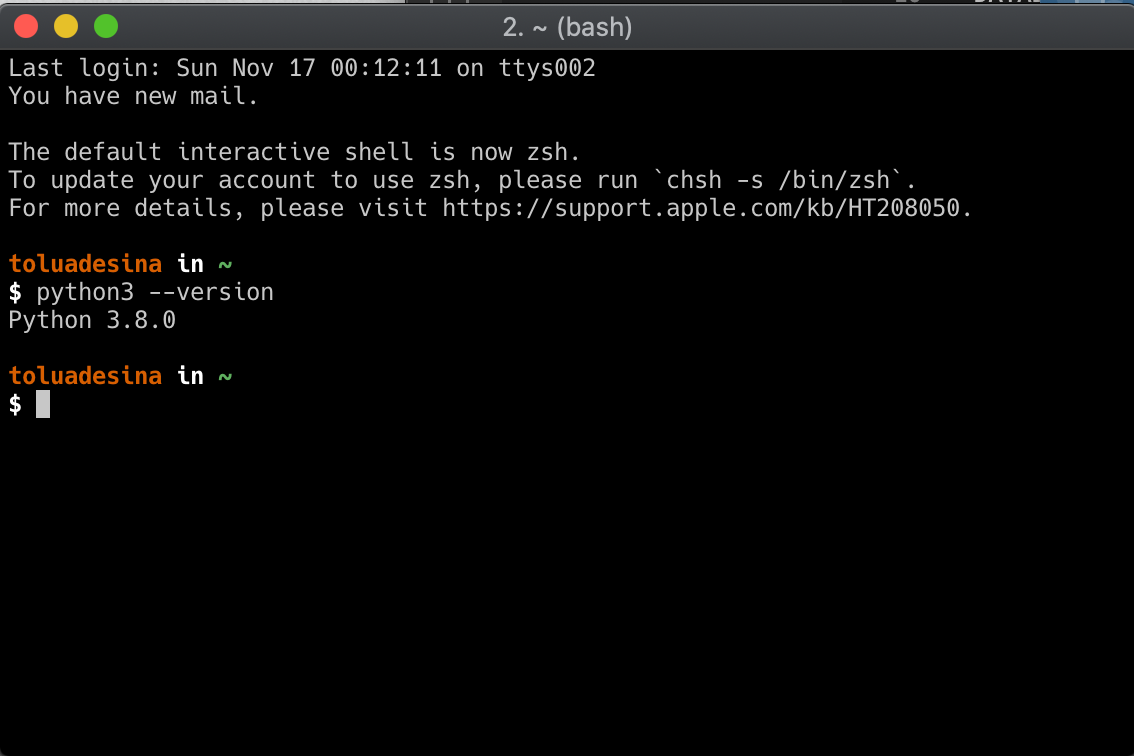Mac OS X comes with Python 2.7 out of the box.
- Python Install Mac Os
- Install Python 3 Mac Catalina
- Install Python 3 Mac Pip
- Install Python 3 Mac Homebrew
Use Python 3 as the macOS default. Python's website has a macOS Python 3 installer we can download and use. If we use the package installation, a python3 fill will be available in /usr/local/bin/. Aliasing is a must since the Python binary stored in /usr/bin/ can't be changed. What's nice about an alias is that it's specific to our command-line. The pip3 is used if the you are using version python 3. Once the package is installed, you can use import requeststo include it to your.py file. Feel free to comment and ask for any further help with this. If you need help with installing. Link to Installing Python 3.8.0+ on your Mac with pyenv podcast on anchorfm Recently I wrote a post entitled Installing the latest version of Python on Mac OS Catalina and overriding the old default pre-installed version about installing Python 3.7.7 on Mac OS Catalina with Homebrew.
You do not need to install or configure anything else to use Python 2. Theseinstructions document the installation of Python 3.

The version of Python that ships with OS X is great for learning, but it's notgood for development. The version shipped with OS X may be out of date from theofficial current Python release,which is considered the stable production version.
The official dedicated python forum. (Oct-20-2019, 02:13 PM) snippsat Wrote: It's no problem to have several version i have had up to 7-8 and also Anaconda/PyPy.ect. If you want to test out Python 3.8 just install,but can still keep 37 as main version in Windows Path.
Doing it Right¶
Let's install a real version of Python.
Before installing Python, you'll need to install GCC. GCC can be obtainedby downloading Xcode, the smallerCommand Line Tools (must have anApple account) or the even smaller OSX-GCC-Installerpackage.
Note
If you already have Xcode installed, do not install OSX-GCC-Installer.In combination, the software can cause issues that are difficult todiagnose.
Note
If you perform a fresh install of Xcode, you will also need to add thecommandline tools by running xcode-select--install How to access downloads on mac. on the terminal.
While OS X comes with a large number of Unix utilities, those familiar withLinux systems will notice one key component missing: a package manager.Homebrew fills this void.
To install Homebrew, open Terminal oryour favorite OS X terminal emulator and run
The script will explain what changes it will make and prompt you before theinstallation begins.Once you've installed Homebrew, insert the Homebrew directory at the topof your PATH environment variable. You can do this by adding the followingline at the bottom of your ~/.profile file
If you have OS X 10.12 (Sierra) or older use this line instead
Now, we can install Python 3:
This will take a minute or two.
Pip¶
Homebrew installs pip pointing to the Homebrew'd Python 3 for you.
Working with Python 3¶
At this point, you have the system Python 2.7 available, potentially theHomebrew version of Python 2 installed, and the Homebrewversion of Python 3 as well.
will launch the Homebrew-installed Python 3 interpreter.
will launch the Homebrew-installed Python 2 interpreter (if any).
will launch the Homebrew-installed Python 3 interpreter.
If the Homebrew version of Python 2 is installed then pip2 will point to Python 2.If the Homebrew version of Python 3 is installed then pip will point to Python 3.
Python Install Mac Os
The rest of the guide will assume that python references Python 3.
Pipenv & Virtual Environments¶
The next step is to install Pipenv, so you can install dependencies and manage virtual environments.
Install Python 3 Mac Catalina
A Virtual Environment is a tool to keep the dependencies required by different projectsin separate places, by creating virtual Python environments for them. It solves the'Project X depends on version 1.x but, Project Y needs 4.x' dilemma, and keepsyour global site-packages directory clean and manageable.
For example, you can work on a project which requires Django 1.10 while alsomaintaining a project which requires Django 1.8.
Install Python 3 Mac Pip
So, onward! To the Pipenv & Virtual Environments docs!
Install Python 3 Mac Homebrew
This page is a remixed version of another guide,which is available under the same license.
